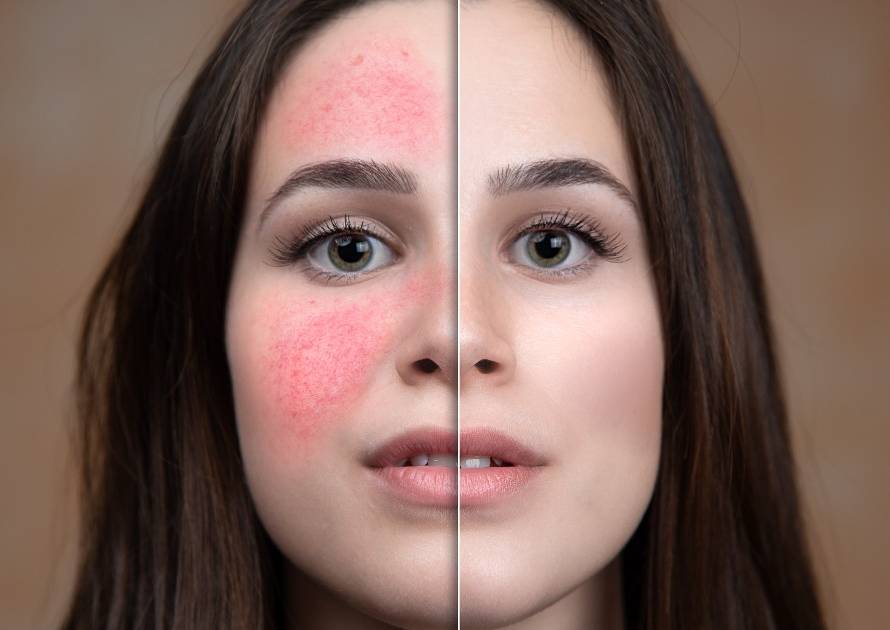If you have recently noticed dark spots appearing on different parts of your face, you might be dealing with an issue called melasma. Melasma can cause embarrassment and lack of confidence for a lot of people, especially when it has developed in an area where it’s visible.
This article will focus on helping you understand the meaning of melasma, its risk factors, types, causes, treatment, and most frequently asked questions regarding melasma. Read on to learn all you need to know about this skin condition and how to get rid of it if you have been a victim of it for a while now.
Overview
Melasma is a chronic skin condition that causes hyperpigmented, brown, and sometimes blue-gray patches to appear on the skin. Melasma can also appear in the form of spots that resemble freckles, and a lot of the time, people mistake melasma for freckles; however, they’re two completely different skin conditions.
Melasma is also known as “the mask of pregnancy” or chloasma. It happens due to the increased number of melanin syntheses (skin pigment cells) which can be either superficial or deep. Studies have recently shown that 90% of the people affected by melasma are women. It especially happens to pregnant women.
Risk Factors that Can Trigger Melasma
Although melasma can develop quite suddenly, it does not develop out of the blue. There is a number of triggers that can stimulate the growth of increased melanin cells, which would result in the skin condition that is melasma. Some of the most common risk factors include:
- Skin color: People with darker skin are more prone to developing melasma.
- Hormonal changes during pregnancy or the intake of oral contraceptive pills: The increased level of the estrogen hormones can trigger melasma. This is why women, especially pregnant women, are at a higher risk of developing melasma.
- Sun exposure: Exposure to the sun can stimulate the production of melanin cells which in its turn triggers melasma to develop on the skin.
- Skin inflammation: Severe skin inflammation disrupts the bottom layer of the epidermis, which causes the pigment to leak into and become trapped in the dermis. This process results in a deeper and more stubborn pigmentation.
- Genetics: Many inherited genetic factors can cause melasma. If one of your grandparents, parents, or siblings has developed melasma, you are also likely to develop it with time. This is especially true for people with darker skin.
Melasma usually affects unexposed areas, mainly the face. However, it can also affect the forearms or chest. It is more common to develop in prominent areas on the face, such as the cheeks, nose, or chin.
How Do Dermatologists Diagnose Melasma at the Clinic?
With melasma, a visual examination is not enough to test whether or not you have a skin condition. Your doctor will perform some tests in order to rule out some specific causes.
One of the best methods that the doctor could use as a test is the wood’s lamp examination. In this examination, the doctor uses a device that contains a light source with a wavelength of 365 mm. the device is held up to your skin, and the doctor tries to determine the level and depth of pigment and also check for bacterial or fungal infections.
Types of Melasma
There are three main types of common melasma, and all of them have to do with the depth of the pigment. As mentioned in the previous section, wood’s lamp light is able to determine the depth of the pigment and hence the type of melasma. The following are the three main types of melasma:
- Epidermal: This is the type of melasma that occurs in the first layer of the skin. This type appears as dark brown colored patches. Moreover, a well-defined border is visible under black light, and it often responds well to treatment.
- Dermal: This type of melasma develops at a deeper level in the skin. It usually has a light brown or bluish color, a blurry border, and appears no differently under black light. This type of melasma is stubborn and does not respond well to treatment.
- Mixed melasma: This is the most common type of melasma. It happens at a deep and shallow level of the skin. This type appears as both bluish and brown patches show a mixed pattern under black light. Mixed melasma responds to treatment fairly.
Treatment of Melasma
There are various methods to treat melasma. Each method treats a certain level of melasma and is decided by the doctor. Here are some of the best treatments used to help with melasma:
- Wear sunscreen with SPF 30 every day, and try to avoid sunlight as much as possible.
- Use makeup to cover up areas of discoloration.
- Topical medications that affect the melanin synthesis pathway such as:
- Hydroquinone cream with a maximum concentration of 4%. This is a common first treatment for melasma. The doctor will advise you to apply it to the skin so that it works to even out your skin tone. This cream can be used daily for up to 2 months.
- Retinoid: This is a vitamin A derivative that is effective in treating superficial hyperpigmentation.
- Topical steroids: Topical steroids have anti-inflammatory properties which will help with treating melasma.
- Triple combination cream which combines fluocinolone acetonide, hydroquinone, and tretinoin.
- Peeling acids such as:
- Chemical peel in the clinic: Dermatologists often use salicylic acid peels in various strengths to eliminate epidermal pigment in the treatment of melasma.
- Pico laser: The doctor will use the fractional handpiece for treating melasma.
- Derma pen with mesotherapy: Tranexamic Acid (TA) mesotherapy is considered to be the most cost-effective, safe, and directly observed therapy for melasma.
Note: Melasma is a chronic disease that needs prolonged treatment along with prophylactic treatment to maintain the results and prevent prolapse.
Frequently Asked Questions (FAQs) Regarding Melasma
This section contains some of the most commonly and frequently asked questions regarding melasma and its treatment methods.
Is melasma common?
Yes, melasma is a very common skin disorder, especially in pregnant women. 90% of those diagnosed with melasma were women. It is more common in women than it is in men due to the increased levels of estrogen hormone in women. Around 33% of the population is prone to developing melasma. It commonly starts between the ages of 20 and 40.
Who is at risk of melasma?
People with darker skin colors are more likely to develop melasma. That is because the increased number of melanin cells increases the risk of developing melasma. Moreover, women are more likely to develop melasma than men are. Pregnant women, especially, get melasma more than anyone else. If someone is taking oral contraceptives and hormones, then you could be at a high risk of developing melasma as well.
Why do women get melasma when they’re pregnant?
Pregnant women have increased levels of the hormones estrogen and progesterone, which are believed to contribute to your melasma. The darker colors usually fade after pregnancy.
Is melasma cancerous?
No, melasma is not a sign of cancer, nor does it turn into skin cancer in the long term. However, there are types of skin cancers that could look like melasma, which is why you need to visit your dermatologist to get a proper diagnosis of your skin condition.
Is melasma permanent?
Melasma is a chronic (long-lasting) disorder. A lot of people suffer from melasma for years or their entire lives. However, most people have melasma for just a short period of time, such as pregnant women.
Is melasma painful?
No, melasma is not painful. It is a harmless skin condition that does not cause pain, itchiness, or discomfort in any way.
Do certain foods affect melasma?
Not really, no. Up until now, no foods or drinks have been proven to directly cause, trigger, or worsen melasma. However, it is beneficial to keep your skin healthy by trying to stick to a skin-healthy diet that contains foods rich in vitamin D, such as:
- Almond milk.
- Eggs.
- Meat.
- Milk.
- Mushrooms.
- Oily fish, such as salmon, sardines, herring, pilchards, trout, and more.
- Orange juice.
- Yogurt.
Are freckles melasma?
No. Melasma can sometimes appear as patches that look like freckles. However, melasma and freckles are not the same types of skin conditions.



